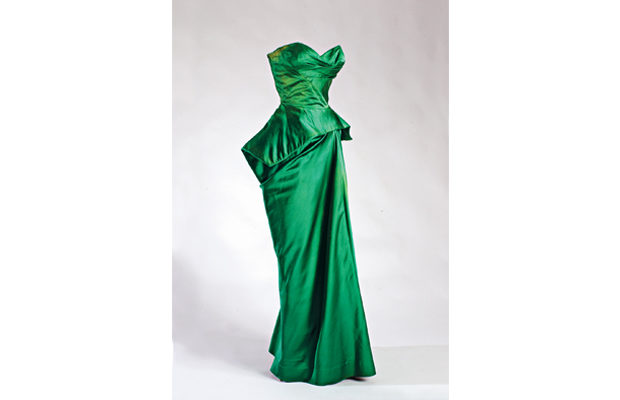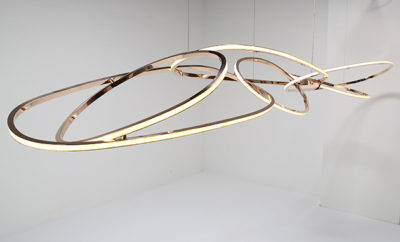
Design
Building Around the Body

A Charles James evening dress made in 1953.
Building Around the Body
In his work on couture collections, furniture, and interiors, Charles James was not so much a designer as a structural engineer.
For all his shortcomings (which were legion), Philip Johnson was a gentleman and comported himself as such. So Johnson’s measured complaint to a client, who commissioned someone else to furnish the interiors of a house that the architect had just finished, would be the equivalent of a virulent screed by someone with no manners. “I admire his work as a dress designer enormously,” Johnson wrote of his replacement, “but you can imagine the disappointment of an architect when someone else finishes his work.”
The client to whom Johnson wrote was Dominique de Menil. In 1949, the architect—an adherent of Bauhaus-style formalism—saw the completion of the one-story brick,steel, and glass villa surrounding a courtyard he designed for de Menil, her husband, John, and their children. Built in a wealthy neighborhood full of historicist mansions, the structure was the first modernist dwelling in Houston—so odd it drew carloads of gawkers. The de Menils loved the simplicity and rationality of their new house, but they also knew they did not want to furnish the place with the angular Mies van der Rohe daybeds and chromed-steel Brno chairs that Johnson would doubtlessly supply. They wanted to soften the building’s stern edges, provide an enclave where they could relax and enjoy their growing collection of modern and ethnographic art, and where the children would feel comfortable. They wanted, as Dominique de Menil said, something voluptuous. If the de Menils had taken a risk with Johnson—who was only beginning his architectural career—they took an even bigger gamble with their still-mysterious choice for a decorator: Charles James, an ingenious couturier, but a man with no experience in interior and furniture design, and, worst of all, a reputation as a perfectionist with a volatile temper.
Among those for whom fashion is the essence of life, James is revered as the first great American couturier. For others he is far less well known: though his clients included boldface-type names such as Dominique de Menil and her daughters, Slim Keith, Babe Paley, Marlene Dietrich, and the wife of William Randolph Hearst Jr., his output was relatively small, and he never entered into any of the successful licensing and ready-to-wear agreements that make a designer a familiar brand name.
James was born in London in 1906, the son of an American mother and a British colonel. After being booted out of Harrow for a sexual romp with a classmate (some say it was Cecil Beaton), James made his way to Chicago, his socialite mother’s hometown, and opened a millinery shop. Moving on from hats, he began to design gowns and dresses, and opened a shop in New York, backed and promoted by celebrity tastemakers such as Beaton and Noël Coward. James went back to Europe in 1930, where he was lauded by such fashion legends as Paul Poiret and Cristobal Balenciaga, and returned to New York after the outbreak of World War II. (James clothes are featured in two shows at the Fashion Institute of Technology Museum in New York: “American Beauty,” currently on exhibit, and “Night & Day,” which opens in early December.) What made James’s work so special? “He was known for his sculptural silhouettes and complex construction,” says FIT curator Molly Sorkin. “His gowns had lots of curves and spirals of fabric, yet it was as if you didn’t even need a body for them to stand up.” Former curator and the author of The Genius of Charles James, Elizabeth Ann Coleman, adds: “He had a fantastic eye for color and was a master of the cut. He’d spend hour on hour getting the shape of a gown just right.” He liked to emphasize the flare of a woman’s hips, and would employ whalebone stays and padding to achieve the desired effect. According to Coleman, “He thought of himself as an engineer.” And yet he was practical. “James cut sleeves short for freedom of movement. When he made clothes for small children, he had the sleeves pointing straight out, because that’s how babies hold their arms,” recalls Christophe de Menil, the family’s eldest daughter. “He made gowns so you could peel away a top layer, add a different one, and have essentially a new dress.”
For the de Menil interiors, James realized—as John and Dominque had apparently intuited—that his skills were fungible. He covered walls in felt or velvet. “He’d put on overalls, go into the garage, and spend all day mixing paint colors,” Christophe de Menil says. “By the time he was satisfied, it was night. And since we didn’t have electricity in the house yet, my sister Adelaide and I would hold flashlights for him while he daubed paint on the walls.” For drama, he convinced the family to acquire pieces by and in the style of John Henry Belter—the mid-nineteenth-century master of the American rococo-revival movement. As counterpoints he designed furniture that showed the sensual side of modernism: a chaise longue whose undulating seat is mirrored by the curves in the frame, a large heptagonal ottoman, a long, curvaceous banquette sofa, and a settee known as the “Lips” sofa. “People compare it to Dali’s ‘Mae West’ sofa,” Christophe says, “but I think it’s far more subtle.” James was anything but subtle in his business and personal life. “Like so many creative people, he had absolutely no business sense,” Coleman says. “And he lived far above his means. And he did things that wiped out his entrée in the fashion world.” For example, he would “borrow back” a gown from one client, and present it to another. He was litigious and demanding, and ruined relationships with potential business partners such as Elizabeth Arden. Always paranoid, toward the end of his days he became convinced that his protégé Halston was stealing his designs. James died penniless in 1978, at that Manhattan elephants’ graveyard of celebrity, the Chelsea Hotel.












